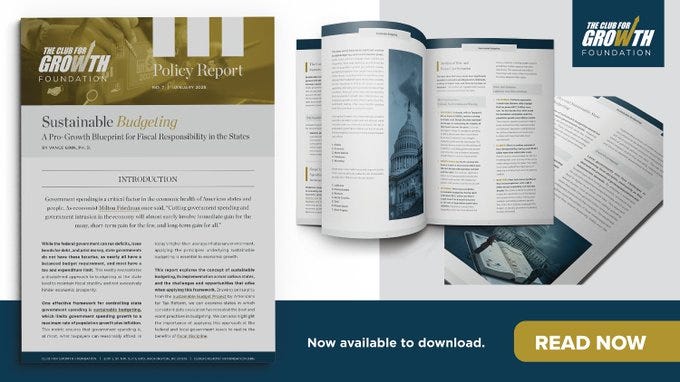We Can't Keep This Up: Federal Spending 101 | This Week's Economy Ep. 104
Why does Congress pass CRs and ignore spending crisis?
Hello Friends!
The U.S. budget deficit surged this year, surpassing $1 trillion, and we’re not even halfway through the fiscal year! While government spending slightly decreased, it still far outpaced revenue, leading to a deficit of over $307 billion for February.
We just saw another federal budget battle in Congress. Despite government shutdown threats, a continuing resolution was passed to fund the government until September. It seems our lawmakers just can’t stick to a spending diet!
But why does federal overspending matter?
In this special edition of This Week’s Economy, I offer a Federal Spending 101 lesson outlining key principles to tackle Congress’s bad financial habits. We need urgent spending reform to turn the economy around—and it’s time lawmakers start listening!
Catch the full episode on YouTube, Apple Podcast, or Spotify, and visit my website for more information.
1. DEFICIT CRISIS HURTS AMERICANS

The Principles:
The federal government’s $36 trillion debt isn’t just a financial issue—it’s a direct threat to economic freedom and prosperity. Every dollar borrowed takes from both us and future generations, limiting growth and innovation. Excessive government spending drives debt and inflation, negatively impacting individuals and businesses.
My Solutions:
Acknowledge the Costs of Spending: The first step is acknowledging the problem. Americans are struggling under the burden of inflation, which is driven by government spending. As the Federal Reserve buys Treasury debt and other assets, its balance sheet swells, printing too much money. This leads to diminished purchasing power, with too much money chasing too few goods.
Commit to Solving the Problem: Congress must prioritize the prosperity of Americans and future generations by addressing overspending head-on.
Seek Fiscal Discipline: The path forward requires fiscal discipline. Politicians must stop focusing on short-term gains that create bloated budgets and waste and instead work toward long-term solutions.
Related Resource: Reducing spending can empower Americans. I explain more at EconLib.
2. SPEND WITHIN YOUR MEANS

The Principles:
American families understand the importance of living within a budget. Most work hard to stay within their credit limits to protect their financial future. Unfortunately, politicians seem to lack this same discipline, recklessly spending other people's money without considering the long-term consequences.
My Solutions:
What is Sustainable Budgeting? A sustainable budget limits spending, capping government growth to a maximum rate of the historical average of population growth plus inflation while returning any surpluses to taxpayers.
Budget Benefits: Spending limits create a more transparent and predictable cap on expenditures. They better align government spending with the average taxpayer’s ability to pay, ensuring that government growth doesn’t outpace the private economy. A sustainable budget helps keep more money in Americans' pockets, reduces spending, and slows the rise of national debt.
State Demonstrates Success: Colorado’s Taxpayer’s Bill of Rights (TABOR) offers a proven model by limiting government spending growth to population increases plus inflation and requiring voter approval for tax hikes. TABOR has kept spending in check even as the state shifted politically, refunded surpluses to taxpayers, and boosted its economy. Applying TABOR’s principles at the federal level could help rein in spending and return power to taxpayers.
Related Resource: I explain how Colorado’s TABOR model could be adopted at the federal level in my piece for National Review.
3. THE REAL THREAT IS SPENDING, NOT SHUTDOWNS

The Principles:
Critics often use the fear of a government shutdown to push through reckless spending bills. But let's be honest: politicians have already shut down schools, economies, and entire communities in recent years. In contrast, a temporary federal government shutdown might be the best solution. It would force a necessary confrontation with the root cause of our fiscal issues: Congress’s addiction to deficit spending.
My Solutions:
End Continuing Resolutions: Relying on stopgap measures and continuing resolutions has become Congress’s default strategy for handling the budget, but it’s time for a change. We need a comprehensive budget reform, not more temporary fixes.
Shutdown Could Help: With growing resistance to any funding bill that cuts spending, a shutdown might be necessary to break the gridlock. It would allow the American people and their representatives to address the real issue: excessive spending. A shutdown is an opportunity to demand concrete solutions, not empty promises or short-term compromises.
Don’t Settle for Less: We must prioritize lasting reforms like spending caps and deregulation for a resilient, pro-growth economy. We shouldn’t settle for less just to avoid conflict. A balanced budget is achievable—with strong economic growth and a commitment to spending restraint. By implementing meaningful reforms now, we can create a more prosperous future.
Related Resource: In my commentary for The Daily Economy, I explored the dangers of avoiding government shutdowns at the expense of fiscal discipline during a late budget battle last year.
4. EXAMINE MAJOR SPENDING AREAS

The Principle:
The greatest national threat remains Congress’s reckless spending, which is primarily driven by so-called “entitlement” programs. These programs need urgent reform through market-based solutions. States are increasingly dependent on federal funds, and the more they rely on Washington, the less control they have over their policies. Medicaid, in particular, is a major driver of this dependency, receiving $616 billion in federal funding in 2023—over half of all federal funds allocated to states.
My Solutions:
Assess Where the Money Goes: Lawmakers must understand where most spending is directed. "Entitlement" programs like Social Security, Medicare, and Medicaid consume the bulk of the budget. Transitioning to personal accounts for savings and/or healthcare spending, implementing means-testing, raising age limits, and eliminating inefficient programs can help protect resources for the most vulnerable while reducing taxpayer burdens.
Cut Waste: Significant waste in the budget can and should be eliminated. Tools like DOGE are helping to identify these areas. Additionally, ending unnecessary programs and regulations, such as the Export-Import Bank, the Jones Act, and excessive occupational licenses, would reduce waste and cronyism.
Welfare Reform: If the federal government continues funding welfare programs, states should demand block grants rather than federally mandated programs. Block grants allow states to design welfare policies that suit their unique economic conditions instead of imposing one-size-fits-all Washington regulations that often create perverse incentives.
Related: My recent commentaries in The Daily Economy discuss the state’s reliance on federal funds and areas of reform for social safety nets.
5. SUSTAINABLE BUDGETING FOR THE STATES

The Principle:
Sustainable budgeting and fiscal responsibility are crucial not only for the federal government but also for state governments. While the federal government can run deficits, issue bonds, and print money, states are bound by strict balanced budget requirements and often face tax and expenditure limits. This requires a disciplined budgeting approach at the state level to maintain fiscal stability and foster long-term economic growth.
My Solutions:
Planning & Strong Spending Limits: Long-term financial planning is essential for sustainability and preparing for economic fluctuations. States should reduce their dependence on federal funds and establish strict spending limits to enforce fiscal discipline. Any surpluses should be used to lower tax rates.
Budget Review & Prioritization: State budget committees should conduct annual evaluations to ensure spending aligns with priorities. Implementing priority-based budgeting will ensure all taxpayer expenditures are thoroughly assessed and justified each budget cycle.
Independent Efficiency Audits: Regular external efficiency audits will enhance transparency, hold government programs accountable, and save taxpayers money.
Related Resources:
Check out my guide at Club for Growth on Sustainable Budgeting: A Pro-Growth Blueprint for Fiscal Responsibility in the States.
I share key data in the Americans for Tax Reform’s Sustainable Budget Project.
For regular updates on the Sustainable State Budget Revolution Across the U.S., visit my website.
Thanks for joining me in this episode of "This Week's Economy." For more insights, visit vanceginn.com and get even greater value with a paid subscription to my Substack newsletter at vanceginn.substack.com.
If you enjoyed this episode, you may also enjoy my guide to policy solutions for federal and state governments seeking to let people prosper! Grab yours here:
God bless you, and let people prosper!
Keep reading with a 7-day free trial
Subscribe to Let People Prosper to keep reading this post and get 7 days of free access to the full post archives.









